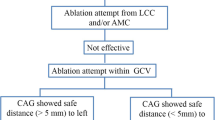Abstract
Objectives
Focal atrial tachycardia (AT) arising from non-coronary cusp (NCC) is very rare, and the experience in catheter ablation of this kind of tachycardia remains limited. This study describes the electrophysiologic characteristics and radiofrequency ablation of AT arising from NCC.
Methods and results
The study population consisted of five consecutive patients (three females and two males; age 37–68 years) with AT arising from NCC. The morphology of P waves was described as positive, negative, isoelectric, or biphasic (positive–negative or negative–positive). The atrial mapping was performed during tachycardia to define the earliest atrial activation site. Mean tachycardia cycle length of AT in five patients was 363 ± 44 ms. P-wave morphology was predominantly upright or biphasic in lead II, III, and aVF, inverted in aVR. Positive P-wave morphology was seen in lead aVL in all five patients. The precordial leads were negative–positive in V1 and V2, negative–positive or positive in lead V3–V5, and positive in lead V6. All the five patients underwent successful radiofrequency ablation within NCC. During a follow up of > 3 months, no patient presented with a recurrence.
Conclusions
This study demonstrated that mapping and ablation of focal AT arising from NCC is safe and effective. When earliest activation was recorded in the proximal electrode of the His-bundle catheter, but radiofrequency ablation in this region cannot successfully eliminated the tachycardia, the AT should be considered to arise from NCC especially when P-wave morphology was initially negative with a late positive component in right precordial leads, upright or biphasic in inferior leads.


Similar content being viewed by others
References
Raatikainen, M. J., & Huikuri, H. V. (2007). Successful catheter ablation of focal atrial tachycardia from the non-coronary aortic cusp. Europace, 9, 216–219.
Ouyang, F., Ma, J., Ho, S. Y., et al. (2006). Focal atrial tachycardia originating from the non-coronary arortic sinus, electrophysiological characteristics and catheter ablation. Journal of the American College of Cardiology, 48, 122–131.
Saoudi, N., Cosio, F., Waldo, A., et al. (2001). A classification of atrial flutter and regular atrial tachycardia according to electrophysiological mechanisms and anatomical bases: a statement from a joint expert group from the Working Group of Arrhythmias of the European Society of Cardiology and the North American Society of Pacing and Electrophysiology. European Heart Journal, 22, 1162–1182.
Lai, L. P., Lin, J. L., & Huang, S. K. S. (2000). Ablation of atrial tachycardia within the triangle of Koch. Radiofrequency catheter ablation of cardiac arrhythmias: basic concepts and clinical applications (2nd ed., pp. 175–183). New York: Futura.
Lai, L. P., Lin, J. L., Chen, T. F., et al. (1998). Clinical, electrophysiological characteristics, and radiofrequency catheter ablation of atrial tachycardia near the apex of Koch’s triangle. Pacing and Clinical Electrophysiology, 21, 367–374.
Iesaka, Y., Takahashi, A., Goya, M., et al. (1997). Adenosine-sensitive atrial reentrant tachycardia originating from the atrioventricular nodal transitional area. Journal of Cardiovascular Electrophysiology, 8, 854–864.
Zhang, T., Li, X. B., Wang, Y. L., et al. (2009). Focal atrial tachycardia arising from the right atrial appendage: electrophysiologic and electrocardiographic characteristics and catheter ablation. International Journal of Clinical Practice, 63, 417–424.
Yin, J. X., Zhou, Y. F., Li, X. B., et al. (2008). Electrophysiologic and electrocardiographic characteristics of focal atrial tachycardia arising from superior tricuspid annulus. International Journal of Clinical Practice, 62, 1008–1012.
Zhao, Z., Li, X., & Guo, J. (2009). Electrophysiologic characteristics of atrial tachycardia originating from the superior vena cava. Journal of Interventional Cardiac Electrophysiology, 24, 89–94.
Kistler, P. M., & Kalman, J. M. (2005). Locating focal atrial tachycardias from P-wave morphology. Heart Rhythm, 2, 561–564.
SippensGroenewegen, A., Peeters, H. A., Jessurun, E. R., et al. (1998). Body surface mapping during pacing at multiple sites in the human atrium: P-wave morphology of ectopic right atrial activation. Circulation, 97, 369–380.
Tang, C. W., Scheinman, M. M., VanHare, G. F., et al. (1995). Use of P wave configuration during atrial tachycardia to predict site of origin. Journal of the American College of Cardiology, 26, 1315–1324.
Kistler, P. M., Haqqani, H., Singarayar, S., et al. (2005). P-wave morphology in focal atrial tachycardia. Heart Rhythm, 2(Suppl. 5), 50–51.
Zhou, Y., Guo, J., Xu, Y., et al. (2007). Electrophysiologic characteristics and radiofrequency ablation of focal atrial tachycardia arising from para-Hisian region. International Journal of Clinical Practice, 3, 385–391.
Author information
Authors and Affiliations
Corresponding author
Rights and permissions
About this article
Cite this article
Zhou, YF., Wang, Y., Zeng, YJ. et al. Electrophysiologic characteristics and radiofrequency ablation of focal atrial tachycardia arising from non-coronary sinuses of Valsalva in the aorta. J Interv Card Electrophysiol 28, 147–151 (2010). https://doi.org/10.1007/s10840-010-9481-9
Received:
Accepted:
Published:
Issue Date:
DOI: https://doi.org/10.1007/s10840-010-9481-9




